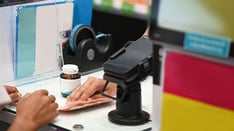Self-administered external trigeminal nerve stimulation (E-TNS) that is available over the counter is superior to sham stimulation in relieving pain for patients with episodic migraine, results from a phase 3 study show.
This is great news for headache patients who want to explore nondrug treatment options, said study investigator Deena E. Kuruvilla, MD, neurologist and headache specialist at the Westport Headache Institute, Westport, Connecticut.
She added, such devices "aren't always part of the conversation when we're discussing preventive and acute treatments with our patients. Making this a regular part of the conversation might be helpful to patients."
The findings were presented at ANA 2021:146th Annual Meeting of the American Neurological Association (ANA), which was held online.
A Key Therapeutic Target
The randomized, double-blind trial compared E-TNS with sham stimulation for the acute treatment of migraine.
The E-TNS device (Verum Cefaly Abortive Program) stimulates the supraorbital nerve in the forehead. "This nerve is a branch of the trigeminal nerve, which is thought to be the key player in migraine pathophysiology," Kuruvilla noted.
The device has been cleared by the US Food and Drug Administration for acute and preventive treatment of migraine.
During a run-in period before randomization, patients were asked to keep a detailed headache diary and to become comfortable using the trial device to treat an acute migraine attack at home.
The study enrolled 538 adult patients at 10 centers. The patients were aged 18 to 65 years, and they had been having episodic migraine, with or without aura, for at least a year. The participants had to have received a migraine diagnosis before age 50, and they had to be experiencing an attack of migraine 2 to 8 days per month.
The patients used the device only for a migraine of at least moderate intensity that was accompanied by at least one migraine-associated symptom, such as photophobia, phonophobia, or nausea. They were asked not to take rescue medication prior to or during a therapy session.
Study participants applied either neurostimulation or sham stimulation for a continuous 2-hour period within 4 hours of a migraine attack over the 2-month study period.
The two primary endpoints were pain freedom and freedom from the most bothersome migraine-associated symptoms at 2 hours.
Compared to sham treatment, active stimulation was more effective in achieving pain freedom (P = .043) and freedom from the most bothersome migraine-associated symptom (P = .001) at 2 hours.
"So the study did meet both primary endpoints with statistical significance," said Kuruvilla.
The five secondary endpoints included pain relief at 2 hours; absence of all migraine-associated symptoms at 2 hours; use of rescue medication within 24 hours; sustained pain freedom at 24 hours; and sustained pain relief at 24 hours.
All but one of these endpoints reached statistical significance, showing superiority for the active intervention. The only exception was in regard to use of rescue medication.
The most common adverse event (AE) was forehead paresthesia, discomfort, or burning, which was more common in the active-treatment group than in the sham-treatment group (P = .009). There were four cases of nausea or vomiting in the active-treatment group and none in the sham-treatment group. There were no serious AEs.
Available Over the Counter
Both moderators of the headache poster tour that featured this study ― Justin C. McArthur, MBBS, from Johns Hopkins University, Baltimore, Maryland, and Steven Galetta, MD, from NYU Grossman School of Medicine, New York City ― praised the presentation.
Galetta questioned whether patients were receiving preventive therapies. Kuruvilla said that the patients were allowed to enter the trial while taking preventive therapies, including antiepileptic treatments, blood pressure medications, and antidepressants, but that they had to be receiving stable doses.
The investigators didn't distinguish between participants who were taking preventive therapies and those who weren't, she said. "The aim was really to look at acute treatment for migraine," and patients taking such medication "had been stable on their regimen for a pretty prolonged period of time."
McArthur asked about the origin of the nausea some patients experienced.
It was difficult to determine whether the nausea was an aspect of an individual patient's migraine attack or was an effect of the stimulation, said Kuruvilla. She noted that some patients found the vibrating sensation from the device uncomfortable and that nausea could be associated with pain at the site.
The device costs $300 to $400 (US) and is available over the counter.
Kuruvilla is a consultant for Cefaly, Neurolief, Theranica, Now What Media, and Kx Advisors. She is on the speakers bureau for AbbVie/Allergan, Amgen/Novartis, Lilly, the American Headache Society, Biohaven, CME meeting, and is on an advisory board at AbbVie/Allergan, Lilly, Theranica, and Amgen/Novartis. She is editor and associate editor of Healthline, and is an author for WebMD/Medscape, Healthline.
ANA 2021: 146th Annual Meeting of the American Neurological Association: Abstract 385. Presented October 17, 2021.
For more Medscape Neurology news, join us on Facebook and Twitter.
Credits:
Lead Image: Dreamstime
Medscape Medical News © 2021
Send news tips to news@medscape.net.
Cite this: DIY Nerve Stimulation Effective in Episodic Migraine - Medscape - Oct 19, 2021.










Comments